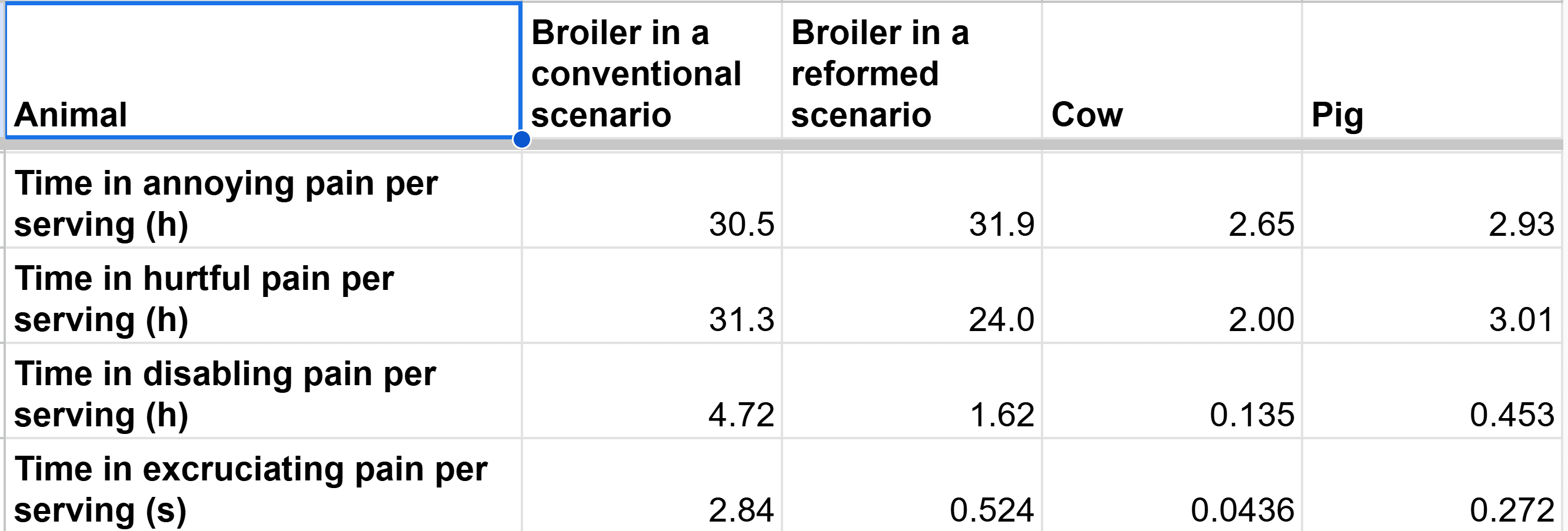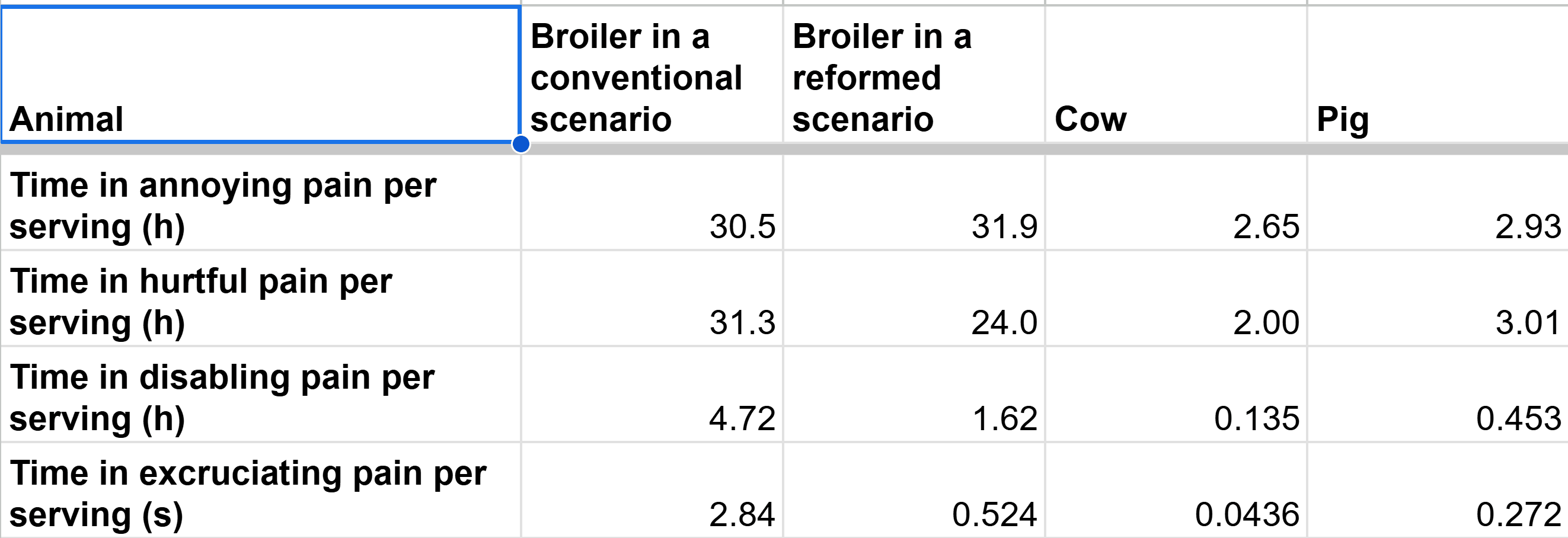This is a crosspost for Replacing chicken meat with beef or pork is better than the reverse, which was written by me, and published on One Step for Animals' blog on 27 November 2024. One Step for Animals is an organisation aiming to cost-effectively decrease animal suffering by asking people to stop eating chickens.
The views expressed here are my own, not those of my employers. Thanks to Matt Ball for inviting me to write something on the trade-offs between animal welfare and greenhouse gas emissions of replacing chicken meat, and feedback on the draft.
Replacing beef or pork with chicken meat decreases greenhouse gas (GHG) emissions, but has major negative impacts on animal welfare. I estimate that replacing one serving of:
- Beef with one from chicken meat from broilers in a conventional scenario, decreases GHG emissions by 6.44 kgCO2eq, but also leads to:
- 27.8 h more of annoying pain.
- 29.3 h more of hurtful pain.
- 4.59 h more of disabling pain.
- 2.79 s more of excruciating pain.
- Pork with one from chicken meat from broilers in a conventional scenario, decreases GHG emissions by 0.212 kgCO2eq, but also leads to:
- 27.6 h more of annoying pain.
- 28.3 h more of hurtful pain.
- 4.27 h more of disabling pain.
- 2.56 s more of excruciating pain.
I calculated the above increases in the time animals spend in pain due to replacing beef or pork based on data from the Welfare Footprint Project (WFP) for broilers. I guess my assumptions underestimate the badness of replacing beef or pork. I assumed cows’ conditions are as bad as those of broilers in a reformed scenario, and pigs’ conditions are as bad as those of broilers in a conventional scenario. I think cows and pigs usually have better conditions, such that I overestimated the time they spend in pain, and therefore underestimated the increase in pain linked to replacing beef or pork.
Here is how WFP defines:
- Disabling pain (2nd most intense). “Pain at this level takes priority over most bids for behavioral execution and prevents most forms of enjoyment or positive welfare. Pain is continuously distressing. Individuals affected by harms in this category often change their activity levels drastically (the degree of disruption in the ability of an organism to function optimally should not be confused with the overt expression of pain behaviors, which is less likely in prey species). Inattention and unresponsiveness to milder forms of pain or other ongoing stimuli and surroundings is likely to be observed. Relief often requires higher drug dosages or more powerful drugs. The term Disabling refers to the disability caused by ‘pain’, not to any structural disability”.
- Excruciating pain (most intense). “All conditions and events associated with extreme levels of pain that are not normally tolerated even if only for a few seconds. In humans, it would mark the threshold of pain under which many people choose to take their lives rather than endure the pain. This is the case, for example, of scalding and severe burning events [in “large areas of the body, dismemberment, or extreme torture”]. Behavioral patterns associated with experiences in this category may include loud screaming, involuntary shaking, extreme muscle tension, or extreme restlessness. Another criterion is the manifestation of behaviors that individuals would strongly refrain from displaying under normal circumstances, as they threaten body integrity (e.g. running into hazardous areas or exposing oneself to sources of danger, such as predators, as a result of pain or of attempts to alleviate it). The attribution of conditions to this level must therefore be done cautiously. Concealment of pain is not possible”.
The decreases in GHG emissions due to replacing one serving of beef and pork are 0.0961 % and 0.00316 % of the GHG emissions per capita in 2023. Do you feel like decreasing your annual GHG emissions by these justifies tens of hours more of annoying pain, tens of hours more of hurtful pain, a few hours more of disabling pain, and a few seconds more of excruciating pain? I do not. Consider whether you would accept such trade-offs if it were your or others’ pets experiencing the additional pain.
There has been some research on how GHG emissions increase mortality from non-optimal temperature. Bressler (2021) calculated that 4.43 kt of additional CO2eq in 2020 would cause one extra human death in total from 2020 to 2100. Based on this, I estimate that 1 kg of CO2eq results in a total loss of 2.43 min of healthy life across all humans and years, or 0.186 ns per person-year (1 ns is 10^-9 s). Consequently, replacing one serving of beef and pork decreases total healthy human life by 15.6 min (beef) and 0.513 min (pork), or 1.20 ns and 0.0394 ns per person-year. Note the negative effects of the additional CO2eq are negligible until 2055 (see Fig. 3 of Bressler (2021)), so they are not only infinitesimal on a person-year basis, but also very uncertain given the difficulty of predicting now what will happen after 2055.
Do you feel like the above negative effects, a few minutes of healthy life lost in total spread across billions of humans over roughly a century, which is not more than a few billionths of one second per person-year, justify one sentient individual experiencing tens of hours more of annoying pain, tens of hours more of hurtful pain, a few hours more of disabling pain, and a few seconds more of excruciating pain? I do not.
Maybe replacing chicken meat with beef or pork could be harmful to wild animals because they require much more land? I agree decreasing the number of wild animals would be bad if their lives were worth living, but no one really knows whether this is the case or not. There is room for lots of suffering due to thirst, starvation, predation, disease and parasitism.
I believe the major drawback of replacing chicken meat with beef or pork is that these may well be worse for your health.
You can always replace chicken meat with legumes to improve your health, save money, or if you are very concerned about GHG emissions (I am not). I have been following a plant-based diet for 5 years. However, know that replacing chicken meat with beef or pork significantly decreases suffering.



Thanks for the discussion!
There is a reduction in pain due to replacing chicken meat from broilers in a conventional scenario with that from a reformed scenario. However, replacing chicken meat from broilers in a reformed scenario with beef or pork still reduces annoying pain by tens of hours, hurtful pain by tens of hours, disabling pain by around 1 hour, and excruciating pain by tenths of seconds. I have now added numbers for these reductions in the sheet, which I got from the numbers below I already had in the sheet for the time in pain by animal.
Both scenarios involve factory-farming. The conventional scenario respects a faster growth rate, 60 g/d in the United States (US) and 62 g/d in the European Union (EU). The reformed scenario respects a slower growth rate, 45 to 46 g/d.
However, I estimate the welfare per chicken-year of the reformed scenario is 92.9 % larger than that of the conventional scenario, accounting for both pain and pleasure, and adjusting WFP's time in pain[1] (for my post on replacing chicken meat by beef or pork, I did not adjust WFP's time in pain). That is quite close to 100 %, which would imply neutral lives in the reformed scenario. So, given uncertainty, it might be that replacing beef or pork with chicken meat from broilers in a reformed scenario increases animal welfare besides decreasing GHG emissions.
The vast majority of chicken meat comes from broilers in a conventional scenario, so replacing chicken meat with beef or pork is still better than the reverse. Yet, I would say at least chickens’ lives can become positive over the next few decades in some animal-friendly countries. In this case, I think replacing beef or pork by chicken meat would be beneficial.